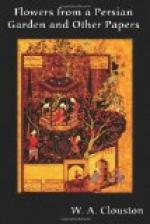APOCRYPHAL LIFE OF ESOP, THE FABULIST.
The origin of the Beast-Fable is still a vexed question among scholars, some of whom ascribe it to the doctrine of metempsychosis, or the transmigration of human souls into different animal forms; others, again, are of the opinion that beasts and birds were first adopted as characters of fictitious narratives, in order to safely convey reproof or impart wholesome counsel to the minds of absolute princes, who would signally resent “plain speaking."[127] Several nations of antiquity—notably the Greeks, the Hindus, the Egyptians—have been credited with the invention of the beast-fable, and there is no reason to believe that it may not have been independently devised in different countries. It is very certain, however, that Esop was not the inventor of this kind of narrative in Greece, while those fables ascribed to him, which have been familiar to us from our nursery days, are mostly spurious, and have been traced to ancient Oriental sources. The so-called Esopic apologue of the Lion and the House is found in an Egyptian papyrus preserved at Leyden.[128] Many of them are quite modern rechauffes of Hindu apologues, such as the Milkmaid and her Pot of Milk, which gave rise to our popular saying, “Don’t count your chickens until they be hatched.” Nevertheless, genuine fables of Esop were current in Athens at the best period of its literary history, though it does not appear that they existed in writing during his lifetime. Aristophanes represents a character in one of his plays as learning Esop’s fables from oral recitation. When first reduced to writing they were in prose, and Socrates is said to have turned some of them into verse, his example being followed by Babrius, amongst others, of whose version but few fables remain entire. The most celebrated of his Latin translators is Phaedrus, who takes care to inform us that
If any thoughts in these Iambics shine,
The invention’s Esop’s, and
the verse is mine.[129]
[127] The reader may with advantage consult
the article
‘Beast-Fable,’
by Mr. Thos. Davidson, in Chambers’s
Encylopaedia,
new edition.
[128] But this papyrus might be of as
late a period as the
second
century of our era.
[129] For the most complete history of
the Esopic Fable, see
vol.
i of Mr. Joseph Jacobs’ edition of The Fables
of
Aesop,
as first printed by Caxton in 1484, with those of
Avian,
Alfonso, and Poggio, recently published by Mr.
David
Nutt; where a vast amount of erudite information
will
be found on the subject in all its ramifications.
Mr.
Jacobs, indeed, seems to have left little for future
gleaners:
he has done his work in a thorough,
Benfey-like
manner, and students of comparative
folk-lore
are under great obligations to him for the
indefatigable
industry he has devoted to the valuable
outcome
of his wide-reaching learning.




